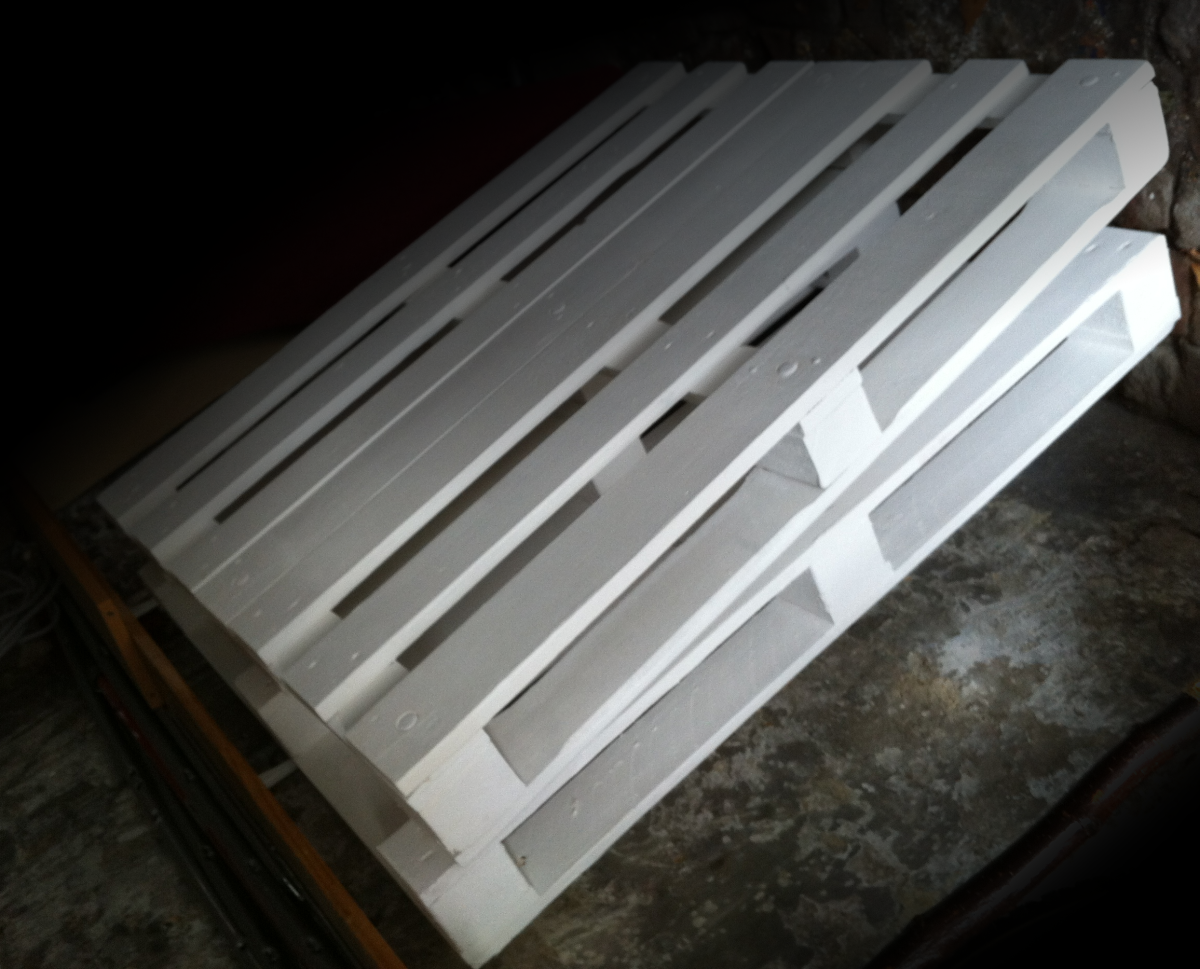
Regarding germany, the point is quite clear: i don’t see any risks connected to the use of pallets in diy furniture, apart from the occasional splinters in fingers during processing. I have to admit that for quite long i wasn’t aware about the typical treatments of wood pallets, though i assumed – correctly, again regarding germany – that there is no toxic tratment of standard euro pallets, and definitely not for my preferred dispoasable pallet. its getting quite obvious when observing rotten pallets: no sign of fungus resistance. Same goes with burning: just pure wood. This is, again, the case for germany, and that quite official, or better, by law:
“Wooden pallets are free from preservatives. This is not only the state of law and regulations, such as the euro-pallet regulation (UIC 435-2, p.10) and the pallet regulation (for the chemical industry CP-building, pp. set 2). This is also shown by a study of Wilhelm Klauditz Institute (WKI), Braunschweig, Germany, in 1993. The investigation probed numerous used pallets and crates and showed no evidence of wood preservatives such as PCP, lindane or dichlofluanid (except two foreign outliers) […] As for wooden pallets no wood preservatives are used, ‘they are comparable with untreated forest wood fuel’. ‘Since wooden packaging is usually untreated material, probably with none of the above recovery options (wood products industry , composting and energy recovery) significant problems with pollutants in the environment should emerge. ‘”
So the Wood Packaging Federation in germany. Sounds good to me. Still, a few precautions should be observed, especially if you’re outside the EU.
Treated pallets from abroad/non-EU

In the U.S. it is warned against fungicides and pesticides, which are used to treat wooden pallets. Additionaly its advised against the possibilities of e.coli contamination or other bacteria.
Organic authority recommends (besides some other good advice) to look for pallets with an “HT” stamp – those pallets are Heat Treated for sterilization instzead of the other and more questionable method of fumigating them with methyl bromide. Greenupgrader even warns against HT stamped pallets, saying that this can also mean treatment with chemicals (what i think is plain wrong). OTOH, according to rootsimple even methylbromide is effectively no problem, for no residue should remain on a pallet after proper areating. I’m undecided on that one, though i tend to think that it is indeed no problem. There are some other more “critical” sources , but i deliberately won’t link to sites like pallettruth.com, for they seem to be quite obvious propaganda pages from plastic pallet producers.
Not an easy one, but again, i think with a clean, preferrably disposable wooden pallet you’re totally OK. Or at least as ok as with any other piece of industrially produced furniture – those aren’t totally untreated wood either.
“A clean wooden pallet” brings us to the next considerable point.
Dirty and impure pallets
Its quite obvious: even untreated pallets are contaminated occasionally. The aforementioned E.Coli history was observed in pallets used for food transport, it can be assumed that a returnable pallet gets soiled depending on the industry it is used in – oil, paint, dust, mold, solvents, whatever can accidentally pour out, in all the different industries pallets are used in. Again, I prefer disposable pallets anyway, those are usually used only once and therefore more likely to remain clean. The basic cleaning and processing of pallets should take care of the “normal” dirt on a pallet before its usage in diy furniture.
So far, so good. Now, since we work from now on with unsoiled and non-harmful pallets, after having them cleaned and grinded, I daresay we’re less at a problem as with many industrially produced furniture made of chipboard and glued plastic wood imitation. “Professional” furniture is not unknown to occationally fuming out solvents, dispersants, formaldehyde and so on.
So what about the second unclear point occationally disputed: how are things with the LCA/ecobalance?
Pallet furniture: ecologically useful upcycling?
Well, imo its an obvious yes and no. I think sustainable resource useage is a Good Thing(tm), but does that include pallets? Wood is renewable, reusable pallets should already have a good ecological balance, and it should make no difference if they’re used until the end of their lifecycle as pallets or as a piece of furniture. Disposable pallets, then? But they’re also erecycled in most cases, worked to chipboard ans similar material. Here the “direct way to furniture” looks like upcycling indeed, but as they are reused the one way or the other, it shouldn’t make a big difference. So, at least, lets try to promote
Useful resource savings
The real positive effect on ecology seems to me the furniture that does not need to be produced. DIY pallet furniture is definitely more resource-efficient than the production of a corresponding piece of furniture of the similar price range by industrial production. We use processed natural wood, we don’t need chemical treatment or solvents, no plastics and we produce less transport/traffic efforts. Another point which plays a role especially with me: stuff gets an usage which is “already there” – remains of old furniture, the remaining half bucket of white wallpaint, a few wooden poles laying around and getting eventually thrown away.


In the pallet sofa i installed, for example, old shelves and bed parts as backrests, all is painted with the rest of the wall colour we used before moving in our actual home. Stuff that would otherwise eventually being thrown away. I like that and it seems to me quite sustainable.



Before using a wooden pallet it is always a best choice to check where those pallets came so, that you’ll know if it’s chemically treated or not.